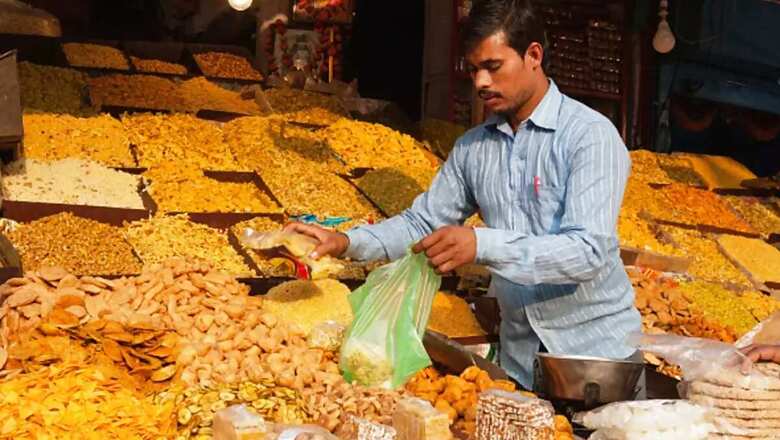
views
Though I admit to espousing my love for meats and seafood, I am a huge fan of Gujarati Farsaan too, the kind you can buy in a ‘Farsaan and Dry Fruit Shop’, the same kind that you will find in any true-blooded Gujarati’s handbag on a plane or a train, or the kind that is served with a Gujarati Thali meal.
Let’s start with my favourite. Jalebi Fafda. I lived just off Chowpatty Beach, in South Mumbai, and right across the road was the Pransukhlal Mafatlal Swimming Bath, a conservative club with separate swimming pools for men and women. The club had a majority of Gujarati members and served the most delicious Jalebi with Fafda at 7 am every day. My parents would put Rs 20 in my hand and send me across to parcel some every Sunday morning. It’d be quite busy even at that early hour as elderly men and women in white kurtas, sarees and tennis shoes, after a slow morning walk on the Marine Drive, would gather to sip some hot chai and snack on Jalebi Fafda. In the North, Jalebi is most often eaten as a sweet dish with Rabdi, garnished with finely chopped almonds and pistachio. But in Gujarat and in parts of Mumbai, Jalebi is eaten as breakfast with Fafda and Sambharo (mildly spiced raw papaya chutney with green chillies). Fafda is fried crunchy salty snack made with besan (gram flour), and flavoured with ajwain and black pepper. The batter is rolled into thin long ribbons and then fried. The sweet squishiness of the Jalebi, the crunchy saltiness of the Fafda and the pungency of the Sambharo is unrivalled.
The same Fafda batter can then be used to make Ghatias. Ghatias are deep-fried extruded strips of besan batter spiced with asafoetida and other spices and can be eaten by themselves or can be part of a mixture for Chivda. The finer extrusion becomes Sev. Each town in Gujarat has its own specialty. Like, the Bhavnagri Ghatia (salty crunchy and peppery) or the Tum Tum of Nadiad, which is similar to a Ghatia, but spicy and crunchy on the outside and soft inside.
When Farsaan Came to My Rescue
I’ve always scoffed and sneered at Gujarati families who can, on demand, produce Farsaan and snacks out of a handbag, whether they are on a plane, train or bus. The Gujaratis are great travellers. But most of them are fussy vegetarians, often don’t eat onion and garlic and hence find themselves in a position where they most often cannot find anything to eat when travelling abroad. So Farsaan always comes to the rescue. Especially Khakhras, Theplas and Dhebras. It was on a long drive from London to Caithness, in far northern Scotland, that I learned the true value of Gujarati Farsaan.
ALSO READ| What The Fork: Kunal Vijayakar on the Rise of Home Chef and a World Sans Biryani, Butter Chicken
My friend Ravi Jobanputra had come to see us off at our London hotel and had brought along a huge bag of Theplas, and an assortment of Chivdas, Ghatias and Khakhras, which he dumped into the back seat of the car, much to my objection, saying, “Throw it away if you don’t eat it”. The drive was long; we often reached our overnight stops after dinner time. Though we’d stop at the frequent ‘Services’ and pick up burgers, sausage rolls and sandwiches and pies, or drive off onto a B-road to find a village pub, every stop just made the drive longer and more tiresome.
It was somewhere after Edinburgh that someone in the back seat decided to open up the foil-wrapped Theplas. The mild aroma of the Indian spices filled the crisp Scotland air. And, we all attacked. I cannot tell you how good it felt to eat some Indian food, albeit cold Theplas. After that, every evening, in the book-lined, wood-panelled study of Ackergill Tower Castle, sitting in front of a crackling fire with single malt in our hands, we munched on Ravi’s stash of Gujarati Khakhras, Chivda, Puris, Ghatia, and Papdi.
My Evergreen Favourites
On top of my list of steamed Farsaan is Khaman and Dhokla. For years, I thought it was a great snack for a diet, after all it was like eating air. Unfortunately not, yet I have never been able to resist the soft, spongy bright yellow Khaman or a nice white diamond-shaped Dholka. There is however just a small difference between Khaman and Dhokla. Khaman is made from gram flour, it’s really moist and slightly sweet. Dhoklas look similar, but are not as moist or spongy, and could be made from a variety of lentils or rice. But both can be tempered with mustard seeds, curry leaves and shredded coconut, and both are lovely, light fluffy snack.
ALSO READ| What The Fork: Kunal Vijayakar on His Love Affair with Poor Man’s Food—Kheema
Till today, when I go to eat a Gujarati Thali, the first thing I look for on the menu is the list of that day’s Farsaan. Soft Patra (colocassia leaves and sweet chickpea batter, rolled, steamed and toasted in ghee) deep-fried Ghugras (small, deep-fried karanjis stuffed with a mash of spiced green peas), Khandvi (steamed gram flour and yogurt batter, tightly rolled and tempered with mustard), Dudhi na Muthiya
(bottle gourd and wheat flour, spiced and steamed and tempered with sesame and mustard), Gota (pakoda made from gram flour and fenugreek leaves) or even Surti Pettis (deep-fried patties of mashed potatoes with a sweet and spicy coconut stuffing), the list is never-ending. It’s like the Gujarati cuisine has a snack for every hour of the day, so much so that when they run out of snacks, they go and make tacos, nachos and burritos their own.
Read all the Latest News, Breaking News and Coronavirus News here. Follow us on Facebook, Twitter and Telegram.




















Comments
0 comment